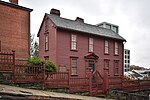John Brown House (Providence, Rhode Island)
Biographical museums in Rhode IslandGeorgian architecture in Rhode IslandHistoric American Buildings Survey in Rhode IslandHistoric house museums in Rhode IslandHouses completed in 1786 ... and 7 more
Houses in Providence, Rhode IslandHouses on the National Register of Historic Places in Rhode IslandIndividually listed contributing properties to historic districts on the National Register in Rhode IslandMuseums in Providence, Rhode IslandNRHP infobox with nocatNational Historic Landmarks in Rhode IslandNational Register of Historic Places in Providence, Rhode Island

The John Brown House is the first mansion built in Providence, Rhode Island, located at 52 Power Street on College Hill where it borders the campus of Brown University. The house is named after the original owner, one of the early benefactors of the university, merchant, statesman, and slave trader John Brown. It was declared a National Historic Landmark in 1968. John Quincy Adams considered it "the most magnificent and elegant private mansion that I have ever seen on this continent."
Excerpt from the Wikipedia article John Brown House (Providence, Rhode Island) (License: CC BY-SA 3.0, Authors, Images).John Brown House (Providence, Rhode Island)
Power Street, Providence
Geographical coordinates (GPS) Address Website External links Nearby Places Show on map
Geographical coordinates (GPS)
| Latitude | Longitude |
|---|---|
| N 41.823055555556 ° | E -71.403333333333 ° |
Address
John Brown House Museum
Power Street 52
02906 Providence
Rhode Island, United States
Open on Google Maps










